Монгол үндэстэн, угсаатны олон мянган жилийн уламжлалт өв соёл гайхамшгийг буухиалан тээгч Буриад зоны урлаг спортын "АЛТАРГАНА-2014" олон улсын наадамд Их Британи-Умард Ирландын нэгдсэн вант улс, ОХУ, БНХАУ, Монгол улсын төр, нийгэм, соёл, урлагийн зүтгэлтнүүд, Буриад зоны элч төлөөлөгч, авьяас билигтэн, эрдэмтэд, судлаачид өргөнөөр оролцлоо.
Human Origin and issues around the subjects: What does it mean to be human?
Pages
▼
Tuesday, July 22, 2014
Friday, July 11, 2014
NATIVE AMERICAN CONNECTION TO 40,000 YEAR OLD HUMAN IN NORTHWEST CHINA
Detailed examination of samples of ancient DNA has revealed the genetic makeup of humans living circa 40,000 years ago in an area near what is now Beijing in China.
International research
An international team of researchers including Svante Pääbo and Qiaomei Fu of the Max Planck Institute for Evolutionary Anthropology in Leipzig, Germany, have sequenced nuclear and mitochondrial DNA extracted from the leg of an early modern human from Tianyuan Cave near Beijing.
Analyses of DNA recovered from the leg bones showed that the Tianyuan human shared a common origin with present-day Asians and Native Americans. In addition, the researchers found the proportion of Neanderthal and Denisovan-DNA in this early modern human is no higher than in current populations living in this region today.
Humans who looked broadly like present-day people started to appear in the fossil record of Eurasia between 40,000 and 50,000 years ago, however many questions remain about the relationship between these early modern humans and present-day Homo sapiens populations.
The leg bone of the early modern human from Tianyuan Cave was used for the genetic analysis as well as for carbon dating.
© MPI for Evolutionary Anthropology
Oldest DNA recovered from early humans
The researchers were using new techniques that could identify ancient genetic material from an archaeological find even when large quantities of DNA from soil bacteria are present.
They then reconstructed a genetic profile. “This individual lived during an important evolutionary transition when early modern humans, who shared certain features with earlier forms such as Neanderthals, were replacing Neanderthals and Denisovans, who later became extinct”, says Svante Pääbo of the Max Planck Institute, who led the study.
The genetic profile showed this early modern human was related to the ancestors of many present-day Asians and Native Americans but had already diverged genetically from the ancestors of present-day Europeans.
“More analyses of additional early modern humans across Eurasia will further refine our understanding of when and how modern humans spread across Europe and Asia”, says Svante Pääbo.
Researchers carrying out excavation works at the Tianyuan Cave from which the leg bones had been excavated in 2003.
© Institute of Vertebrate Paleontology and Paleoanthropology (IVPP), Beijing
Dienekes Pontikos, who runs the influential Dienekes blog on human population genetics comments that “This is an important finding because some published demographic models had Europeans and East Eurasians diverging as recently as 20 thousand years ago.”
He adds, “It now appears that they did so already at around the time of the Upper Palaeolithic revolution, when unambiguous evidence of modern humans across Eurasia exists.”
Around 40,000 years ago, Neanderthals and Denisovans were being replaced by Homo sapiens and it is these genetic studies of people living at the important crossover period that could help scientists understand when and how this interbreeding took place as well as answering the question of how and when modern humans began their colonisation of the globe.
Parts of the work was carried out in a new laboratory jointly run by the Max Planck Society and the Chinese Academy of Sciences in Beijing.
Source: PNAS/Max-Planck-Gesellschaft, München
Monday, July 7, 2014
Sunday, July 6, 2014
Saturday, July 5, 2014
Пазюрик соёл - Southern Siberia/Pazyryk
Southern Siberia/Pazyryk
Пазюрик соёл бол Хүрлийн сүүл үе буюу төмрийн эрин үед
хамаарах Алтай болон Сибирийн мөнх сэвдэгт, сэрүүн уур амьсгалд хамаарах бүсээс
олдсон археологийн соёл
юм. Пазюрик соёл ойролцоор МЭӨ VII-III зууны үед
оршин тогтнож байсан Скиф хүмүүсийн төлөөлөл нүүдэлчид ажээ. Антропологийн
төхөл нь Европжуу... Эдүгээ энэ соёлын ул мөр Монгол улсын өрнөд хязгаарт
хамаарч байдаг. Пазюрик соёлоос маш олон тооны соёлын олдвор, дурсгалууд олдсон
бөгөөд муугүй хадгалагдсан мумми бас олдсон. Энэ соёлын онцлог болоод эдлэл
хэрэглэл зэрэгт хийсэн анализ судалгаагаар Скиф хэлвэрт соёлын нэг салаа
болохыг нотолсон. Пазюрик соёлтой тун төстэй хиргисүүрийн соёлууд бий агаад тэд
бүгдийг олдсон газар нутгийн нэрээр нь Башадар, Туэкта, Уландрык, Полосьмак
болон Берел гэж нэрлэдэг аж. Еврази дахь эдгээр соёлын бүрдэл нь өөрийн гэсэн
нэг онцлогтой хэдийч алс дорнод хэв маяг, нүүдэлчдийн өвөрмөц соёлын харилцан
зээлдлэгт орсон байдаг.
Скифүүдтэй тун төстэй эртний овог аймаг бол Пазюрикчууд
агаад тэд МЭӨ VI-IV зууны
үед Алтай нуруу өөрөөр хэлвэл эдүгээх Казакстан, Хятад, Монгол нутаг дэвсгэр
дээр оршин тогтнож байжээ.
... Пазюрик хүмүүс гэж ер нь хэн вэ? Гэсэн алван ёсны асуулт гарах нь зүйн
хэрэг бизээ. Энэ талаархи цөөнгүй эрдэмтэд судалгаа хийж дээрхи асуултын
хариулт гаргаж ирэхийг зорисон юм. Дэлхий дээр маш олон овог аймгууд нэгэнд
газар дээр бус өөр соёлын хамааралтайгаар угсаажилтын онцгой бүрдэл үүтгэн
амьдарч байсан нь үнэн бөгөөд энэ төрөл популяци бүхий нийгмийн нэг олдворт
эцсийн хариулт гарч ирэх үнэмлэхүй үнэнг батлах баримт нэгэнт гарч иржээ. Тэд
буюу Евразийг дамнан нүүдэллэх эртний овгуудийн эдлэж хэрэглэж байсан бүх зүйлс
харилцан адилгүй нэг хэвэнд цутгасан гэж хэлэхгүй ч эхлэл цэг гэх онолд Мария
Гумбутас зэргийн эрдэмтдийн онолд дүйхүйц Понтик хэв шинжийн буюу Гредотийн
дурдсан Скиф ард түмний салаа болох нь үнэмшим.
МУММИ
Толгойлогчийн биеийн шивээс нь гойд тансаг бүрэн дүүрэн
шивээсний урлагаар дүрсэлсэн агаад
дүрслэлийн үндсэн сэдэв нь ан, амьтаны хэв маягтай байна. Эдгээр сэдэв бүхий
дүрсийн бэлэгдэл шинж нь магадгүй эмчилгээ эсвэл анчин хүмүүсийн амьдралын
хэмнэлтэй нэн ойрхон дүрсэлсэн байх бүрэн үндэслэлтэй.
Скифийн толгойлогчийн мумми бол энэ төрлийн олдворт
хамаарах гайхалтай мумми. 1947 онд өмнөд
Киев хотын орчимд олсон бөгөөд Сибирийн Пазюрик олдворуудтай тун ижил агаад
мумми олдсон газар нутаг цаг агаарийн бүсчлэлт хамаарал онцлогууд нэн төстэй.
Энэ үүднээс Скиф, Пазюрик хоёр генетик хамаадал буйг тус бүрд олдсон соёлын
тодорхой баримт бүрээс баталдаг. Сонирхолтой нь энэ хоёр соёлын хооронд ялгаа
бус амьтны загварт урлагийн өвөрмөц төст зүйл гарч ирсэнд байгаа юм. Язгууртан
толгойлогчийн биен дээрхи шивээс нь тун баялаг сэдвийн загвараар мөр, гар, хөл
болон түүний цээжний хэсэг бүрт зурсан байхаас гадна мөр, нурууны хэсгийн
шивээсүүд гойд анхаарал татдаг. Учир нь эдгээр төрлийн шивээс нь эртний
эмчилгээний итгэл үнэмшилд тулгуурласан дүрслэл байж болох бүрэн боломжтой юм.
 |
Алтайн язгууртаны биен дээрхи шивээс, Пазюрик булш 2 V Зууны үе.
|
2003 оны дараа гурван мумми олдсон бөгөөд нийт дөрвөн
мумми болсон юм. Пазюрик толгойлогч, морь унагч болон мөсөн бүсгүй зэрэг
шивээст хүмүүсийн цогцосуудыг эдүгээ Эрмитажийн музейд хадгалж байна. Нийт
дөрвөн мумми тусгай хамгаалалттай агуулханд байгаа бөгөөд дөрвөн муммигийн
гурав нь Алтайгаас авчирсан даруй судалгааны
эргэлтэнд оруулсан байна. Ялангуяа Пазюрик булшны он цаг нь МЭӨ IV-III
жилийн үед хамаарах бөгөөд сонирхолтой нь тус муммийн зарим тэмдэг шивээс сайн харагдахаас
гадна арьс нь хүрэн бор өнгөтэй ба улмаар шивээс нь их тод мэдэгдэх шалтгаан
болсон бизээ. Шивээс бүр танин мэдэхүйн сонирхолтой мэдээлэл болсон. Цааш
нарийвчлан инфра хэт улаан туяаны аргаар гурван мумми тус бүрийн шивээсийг илүү
тод гаргаж чадсан.
 |
| Пазюрик хивс дээрхи дүрслэл. Эвэртэн домгийн Грифон дүр. |
The List of Pazyryk culture's remains. Which are located in south Sibir. We can see further more looking for many articles on Google search system and if you would love to get some articles, I will send to your Email address. Contact with us on this link of my Email (mr.batchuluun@gmail.com) Thanks for reading my blog.
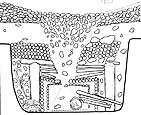 | Drawing of section of Pazyryk Barrow no. 5. 252-238 BCE. Rudenko 1953, p. 33, fig. 11; Rudenko 1970, p. 20, fig. 6. |
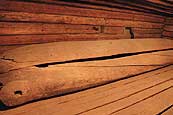 | Sarcophagus in reconstruction of burial chamber. Pazyryk, Altai, Barrow no. 5. 252-238 BCE. Rudenko 1953, pl. XV; Rudenko 1970, pls. 29, 30. |
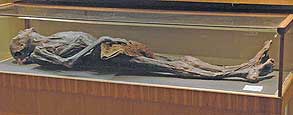 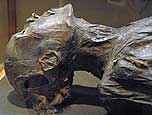 | Mummified body of a man. Pazyryk Barrow no. 5. 252-238 BCE. Rudenko 1953, p. 329, fig. 188, p. 331, fig. 189, pl. XVIII/3; Rudenko 1970, pls. 44d, 45, 46. |
 | Mummified head of a man. Pazyryk barrow no. 2, 300-290 BCE, excavated in 1947-1948. 60x28 cm. Pub.: Rudenko 1953, pl. XVIII, figs. 1, 2; p. 65; Rudenko 1970, p. 44A; pp. 46-47. |
   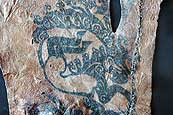 | Tattooed skin of right arm of man, showing various monsters. Pazyryk barrow no. 2, 300-290 BCE. Pub.: Rudenko 1953, p. 139, 298-302, 309-315; Rudenko 1970, pp. 111, 251-253, 260-266; Scythian 1969, cat. no. 52; Rudenko 1968, fig. 10, p. 24. Hermitage website. |
 | Wooden headdress with pigtail. Pazyryk barrow no. 5. 252-238 BCE. Pub.: Rudenko 1953, p, 123; pl. XXVI/2; Rudenko 1970, pp. 97-98; pl. 66a. |
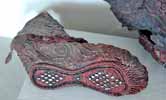 | Woman's boot. Pazyryk barrow no. 2, 300-290 BCE. Leather, textile, tin (or pewter), gold, pyrites. H. 36 cm. Inv. no. 1681/218. Pub.: Rudenko 1953, pp. 118-121; pl. XXV/2; Rudenko 1970, pp. 93-97; pl. 64; From the Lands, cat. no. 125. |
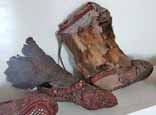 | Women's footwear. Pazyryk barrow no. 2, 300-290 BCE. H. of fur-trimmed boot, 25 cm. Pub.: Rudenko 1953, pp. 118-121; pl. XCIII/3, XCVI/4; Rudenko 1970, pp. 93-97; 152C, 155D. |
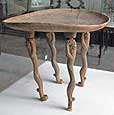  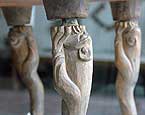 | Table with carved lion legs. Pazyryk, Altai, Barrow no. 2, 300-290 BCE. Rudenko 1953, pls. XIX, XX; Rudenko 1970, pls. 50-51. |
 | Man's head-dress. Pazyryk barrow no. 3, 299-260 BCE. Felt, leather, gold. Pub.: Rudenko 1953, p. 113-115; pl. XCVI/2; Rudenko 1970, p. 90-91; pl. 155B. |
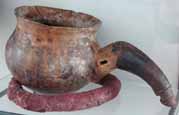 | Spherical vessel and stand. Pazyryk barrow no. 2, 300-290 BCE, excavated 1947. Birch, with horn handle and felt stand. H.15.3 cm.; diameter of base 18 cm. Inv. No. 1684/47, 48. Pub.: Rudenko, 1953, pl. XXI/1; Rudenko 1970, pl. 54/A; Golden Deer, cat. no. 193, p. 268. |
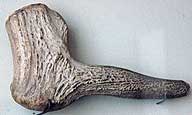 | Mallet. Pazyryk, Altai, Barrow no. 2, 300-290 BCE. Antler. Rudenko 1953, pl. LXXIII/8; Rudenko 1970, pl. 125/G. |
 | Drum. Pazyryk, Altai, 3rd c. BCE. |
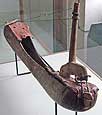 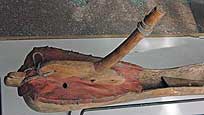 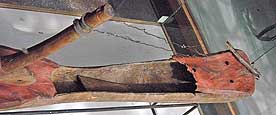 | Musical instrument analogous to a harp. Pazyryk, Altai, Barrow no. 2, 300-290 BCE. Rudenko 1953, pl. LXXXVI/1; Rudenko 1970, pl. 146. |
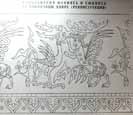 | Drawing of felt applique decoration for carpet or wall hanging, depicting sphynx ("stag-demon") and fantastic bird. Pazyryk barrow no. 5, 252-238 BCE, excavated 1949. Preserved piece 110x80cm. Inv. 1687/1. Rudenko 1953, pp. 321-323; pl. CXIV; Rudenko 1970, pp. 274-276; pl. 173; Rudenko 1968, pp. 66-68, 63 (fig. 51); Golden Deer, cat. no. 196, pp. 272-273. Cf. another carpet in similar technique on Hermitage website. |
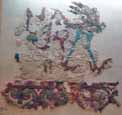 | Fragment of applique decoration for carpet or wall hanging, depicting bird. Pazyryk barrow no. 5, 252-238 BCE. Felt. Pub.: Rudenko 1953, pl. XC; Rudenko 1970, pl. 149; Golden Deer, p. 273. |
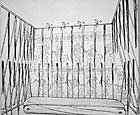 | Drawing reconstructing “tent” and wall hanging of Pazyryk Barrow no. 5, 252-238 BCE. Cf. Rudenko 1953, pls. LXXXVIII, XCV; Rudenko 1970, pls. 147, 154. |
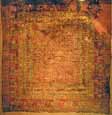 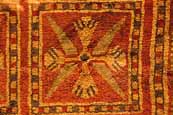 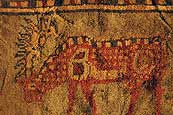 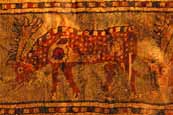 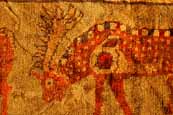 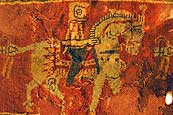 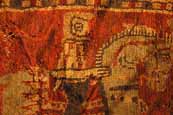 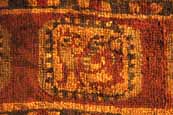 | Pile carpet. Pazyryk barrow no. 5, 252-238 BCE. Wool. 183 x 200 cm. Pub.: Rudenko 1953, pp. 351-356; pl. CXV-CXVI; Rudenko 1968, Ch. 2; Rudenko 1970, pp. 298-304; pl. 174-175; Opie, Tribal Rugs, Ch. 3; Hermitage website. |
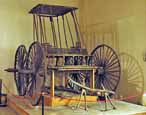 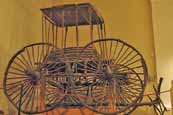 | Carriage (reconstructed from dismantled pieces). Pazyryk barrow 5, 252-238 BCE. Wheel diameter 150 cm.; axle length 3.1 m. Pub.: Rudenko 1953, pp. 232-235; Rudenko 1970, pp. 189-193, pl. 129, 131; Hermitage website, view 1, view 2. |
 | Swan, decoration on felt rug of carriage. Pazyryk barrow no. 5, 252-238 BCE, excavated 1949. Felt, L. 35 cm. Inv. no. 1687/262. Pub.: Rudenko 1968, fig. 77, p. 86; From the Lands, cat. no. 118, color pl. 25; cf. Rudenko 1953, pl. CVIII; Rudenko 1970, pl. 166; Hermitage website. |
 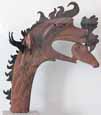 | Carved finial (crest) of unknown object. Pazyryk barrow no. 2, 300-290 BCE. Wood, leather. H. 35 cm. Inv. no. 1684/170. Pub.: Rudenko 1953, pl. LXXXIII; Rudenko 1970, pl. 141; Scythian 1969, cat. no. 47; Charrière no. 358; From the Lands, cat. no. 133. |
 | Horse tails wrapped in gold foil. Pazyryk, Altai, 2nd Bashadar barrow (?), 6th or 5th c. BCE (date uncertain, but earlier than other Pazyryk graves). |
 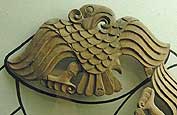 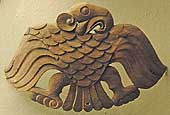 | Reconstruction of saddle decoration Pazyryk, Bashadar Barrow, Altai, 6th or 5th c. BCE (date uncertain, but earlier than other Pazyryk graves), excavated 1950. Wooden vulture ornament to right, H.14.5 cm. Inv. no. 1793/347. Pub.: Rudenko 1960, fig. 145d, p. 286; From the Lands, cat. no. 111; wooden ornament to left, Rudenko 1968, fig. 18, p. 29. |
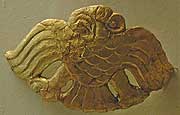 | Bird-shaped ornament covered in gold foil. |
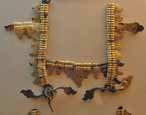 | Bridle. Pazyryk, 2nd Badashar barrow,6th or 5th c. BCE (date uncertain, but earlier than other Pazyryk graves). Leather, with bronze and gold decoration. Pub.: Rudenko 1960, pl. XXXV. |
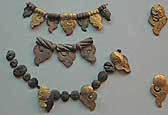   | Reins and chest strap for saddle (separate pieces). Wood, gold foil. Pazyryk, Altai, 2nd Bashadar barrow, 6th or 5th c. BCE (date uncertain, but earlier than other Pazyryk graves). Rudenko 1960, pls. XLIII-XLVI. |
 | Fragment of saddle-cloth hanging depicting tiger. Pazyryk, 2nd Bashadar barrow, 6th or 5th c. BCE (date uncertain, but earlier than other Pazyryk graves). Felt. Pub.: Rudenko 1960, pl. CXXII. |
 | Decorations for saddle hanging, forming image of tiger head. Pazyryk, Altai, 2nd Bashadar barrow, 6th or 5th c. BCE (date uncertain, but earlier than other Pazyryk graves). Wood, covered with gold foil; originally attached to red felt. Rudenko 1960, pl. CXVI. |
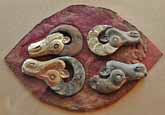 | Decoration with rams' heads for front bow of a saddle. Pazyryk, 2nd Bashadar barrow, 6th or 5th c. BCE (date uncertain, but earlier than other Pazyryk graves). Wood, decorated with gold leaf and sewn on red felt. Pub.: Rudenko 1960, pl. CXVI/2. |
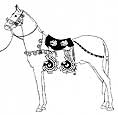 | Reconstruction drawing of horse with harness. Pazyryk, Altai, Barrow no. 1, 305-288 BCE, second riding outfit. |
 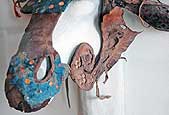 | Decorative hangings for saddle blankets. Pazyryk, Altai, Barrow no. 1, 305-288 BCE The first set from Barrow no. 1 (second riding outfit) depicts a ram’s head seized by a fish. Rudenko 1953, p. 285, fig. 167; Rudenko 1970, pl. 47. |
 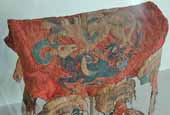  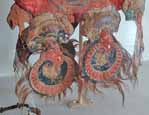 | Saddle cover depicting gryphon attacking a mountain goat. 2nd riding outfit, Pazyryk barrow no. 1, 305-288 BCE, excavated 1929. Felt, leather, fur, hair and gold, L. 119 cm. Inv. no. 1295/150. Pub.: Rudenko 1953, pl. LXXVII, CXI, CXII; Rudenko 1968, ill. 13, p. 27; Rudenko 1970, pl. 135, 170-171; From the Lands, cat. no. 112, pl. 24; Scythian 1969, p. 9; cat. no. 45; Hermitage website. |
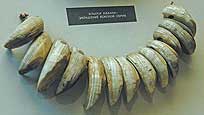 | Boars’ teeth, decoration for horse harness. Pazyryk, Altai, 2nd Bashadar barrow (?), 6th or 5th c. BCE (date uncertain, but earlier than other Pazyryk graves). Cf. Rudenko 1960, pl. XX/1-3. |
 | Horse head-dress (drawing). Pazyryk, Altai, Barrow no. 1, 305-288 BCE. Rudenko 1953, p. 220, fig. 134; Rudenko 1970, pl. 122/A. |
 | Horse head-dress. Crest in form of mountain goat with bird sitting on it. Pazyryk, Altai, Barrow no. 2, 300-290 BCE. Rudenko 1953, p. 223, fig. 137; Rudenko 1970, pl. 122/B |
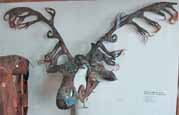 | Horse mask in form of deer antlers. 5th riding outfit, Pazyryk barrow no. 1, 305-288 BCE. Pub.: Rudenko 1953, pp. 214, 219; pl. LXXI/1; Rudenko 1970, p. 179; pl. 119; Charrière, fig. 266. |
 | “Ibex horn” for horse mask. Wood, covered in gold and silver foil. Pazyryk, Altai, 2nd Bashadar barrow, 6th or 5th c. BCE (date uncertain, but earlier than other Pazyryk graves). Rudenko 1960, pl. XXXVIII. |
 | Model of horse head wearing bridle. Pazyryk, Altai, Barrow no. 1, 305-288 BCE, first riding outfit. Rudenko 1953, pl. XXXI; Rudenko 1970, pl. 79A. |
 | Bridle. Pazyryk, Altai, Barrow no. 1, 305-288 BCE, 5th riding outfit. Rudenko 1953, pl. XXXVI; Rudenko 1970, pl. 84. |
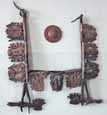 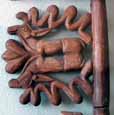 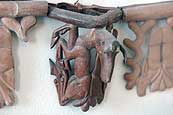 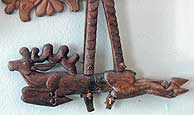 | Horse bridle; detail pendant carved in paired deer. Pazyryk, Alrai, Barrow no. 1, 305-288 BCE. 8th riding outfit, wood, leather. Pub.: Rudenko 1953, pl. XL, XLI; Rudenko 1970, pl. 88, 89; Scythian 1969, cat. no. 44; cf. Charrière, nos. 263, 268. |
 | Saddle blanket, hangings with lion heads and chest harness decoration. Pazyryk, Altai, Barrow no. 1, 305-288 BCE Rudenko 1953, p. 283, fig. 166, pl. CXII; Rudenko 1970, pls. 48, 172. |
 | Bridle, possibly for draught horse. Pazyryk, Altai, Barrow 5, 252-238 BCE. Leather, wood, gold. Pub.: Rudenko 1953, pl. LXX/1-2; Rudenko 1970, pl. 118/A-B. |
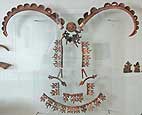 | Bridle ornaments including “ibex horns”. Pazyryk, Altai, 1st Tuekta barrow, 430-420 BCE. Rudenko 1960, pl. LXX. |
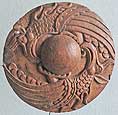 | Decorative disk for forehead of bridle. Pazyryk, Altai, 1st Tuekta barrow, 430-420 BCE. Rudenko 1960, pl. CI/1. |
 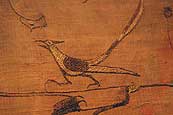 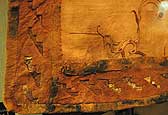 | Covering for felt saddle-cloth, Chinese origin. Pazyryk, Altai, Barrow 5, 252-238 BCE, fifth riding outfit. Embroidered silk. Rudenko 1953, pp. 214-218, figs. 129-132, pl. CXVIII; Rudenko 1970, pp. 174-178, pl. 178. |
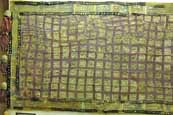 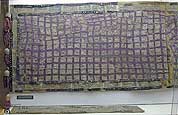 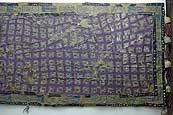 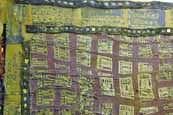 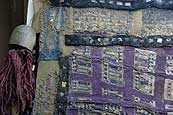 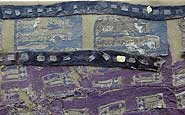 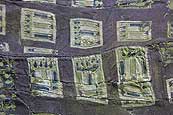 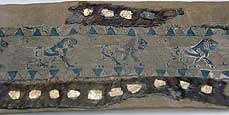 | Covering for felt saddle-cloth (shabrack), probably of middle-eastern origin. Pazyryk, Altai, Barrow no. 5, 252-238 BCE. 1st riding outfit, Fine wool. W. min. 60 cm. Pub.: Rudenko 1953, p. 207; pl. CXVII; Rudenko 1968, pp. 73-79; Rudenko 1970, p. 168; pl. 177. |
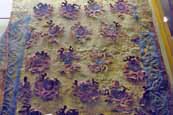   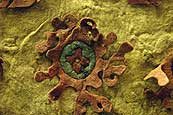 | Saddle-blanket (shabrack). Pazyryk, Altai, Barrow no. 5, 252-238 BCE. 2nd riding outfit, felt. 70 x 236 cm. Pub.: Rudenko 1953, p. 208; pl. CI; Rudenko 1970, p. 169; pl. 160; Charrière, fig. 120. |
   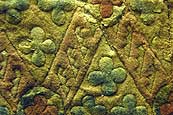  | Saddle blanket (shabrack). Pazyryk, Altai, Barrow no. 5, 252-238 BCE. 4th riding outfit, felt. 65 x 233 cm. Pub.: Rudenko 1953, p. 210; pl. CIII; Rudenko 1970, p. 173; pl. 162. |
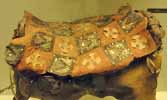  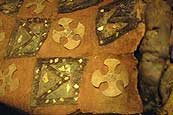 | Saddle cover but with various decorative hangings not shown. Pazyryk, Altai, Barrow no. 5, 252-238 BCE. 5th riding outfit. Pub.: Rudenko 1953, pp. 210-218, esp. fig. 128; Rudenko 1970, pp. 172-177, esp. fig. 88. Individual parts of decoration shown in separate plates. |
  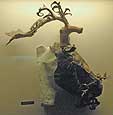 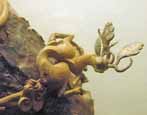 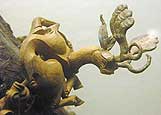 | Bridle and stag decoration of horse head. Pazyryk, Altai, Barrow no. 5, 252-238 BCE. 5th riding outfit. Pub.: Rudenko 1953, pp. 210-212; fig. 127, pls. LXVIII, LXIX, LXXI; Rudenko 1970, pp. 171-174; fig. 87, pls. pls. 116, 117, 121C-D. |
 | Map showing cultural boundaries and connections of Pazyryk nomads. |
 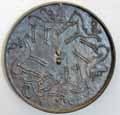 | Mirrors. On left, mirror [7th-4th c. BCE], 8th-7th c. BCE, excavated Ust'-Bukhtarma, Altai Mountains. Bronze. Dia.13.5 cm. Inv. no.GE 1122/54. Pub.: Golden Deer, no. 169, p. 248. |
 | "Cup" with ibex. "Tatar" culture, 6th-3rd c. BCE "Tatar" culture, 6th-3rd c. BCE. Bronze, |
 | Deer ornaments. Tatar culture, 6-3 c. BCE, middle Enisei region. Bronze. |
 | Petroglyph of hunter with bow. 6th-3rd c. BCE Gora Oglakhti, Krasnoiarsk krai. |
 | Fragment of bridle which lacked iron bit. Zabaikal region, tomb 5., S. Saiantui. Bone. |
 | Cauldron. Minusinsk Basin. Bronze. |










